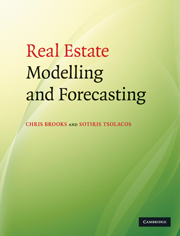Book contents
- Frontmatter
- Contents
- List of figures
- List of tables
- List of boxes
- Preface
- Acknowledgements
- 1 Introduction
- 2 Mathematical building blocks for real estate analysis
- 3 Statistical tools for real estate analysis
- 4 An overview of regression analysis
- 5 Further issues in regression analysis
- 6 Diagnostic testing
- 7 Applications of regression analysis
- 8 Time series models
- 9 Forecast evaluation
- 10 Multi-equation structural models
- 11 Vector autoregressive models
- 12 Cointegration in real estate markets
- 13 Real estate forecasting in practice
- 14 The way forward for real estate modelling and forecasting
- References
- Index
12 - Cointegration in real estate markets
Published online by Cambridge University Press: 05 June 2012
- Frontmatter
- Contents
- List of figures
- List of tables
- List of boxes
- Preface
- Acknowledgements
- 1 Introduction
- 2 Mathematical building blocks for real estate analysis
- 3 Statistical tools for real estate analysis
- 4 An overview of regression analysis
- 5 Further issues in regression analysis
- 6 Diagnostic testing
- 7 Applications of regression analysis
- 8 Time series models
- 9 Forecast evaluation
- 10 Multi-equation structural models
- 11 Vector autoregressive models
- 12 Cointegration in real estate markets
- 13 Real estate forecasting in practice
- 14 The way forward for real estate modelling and forecasting
- References
- Index
Summary
Learning outcomes
In this chapter, you will learn how to
highlight the problems that may occur if non-stationary data are used in their levels forms:
distinguish between types of non-stationarity;
run unit root and stationarity tests;
test for cointegration;
specify error correction models;
implement the Engle–Granger procedure;
apply the Johansen technique; and
forecast with cointegrated variables and error correction models.
Stationarity and unit root testing
Why are tests for non-stationarity necessary?
There are several reasons why the concept of non-stationarity is important and why it is essential that variables that are non-stationary be treated differently from those that are stationary. Two definitions of non-stationarity were presented at the start of chapter 8. For the purpose of the analysis in this chapter, a stationary series can be defined as one with a constant mean, constant variance and constant autocovariances for each given lag. The discussion in this chapter therefore relates to the concept of weak stationarity. An examination of whether a series can be viewed as stationary or not is essential for the following reasons.
• The stationarity or otherwise of a series can strongly influence its behaviour and properties. To offer one illustration, the word ‘shock’ is usually used to denote a change or an unexpected change in a variable, or perhaps simply the value of the error term during a particular time period. For a stationary series, ‘shocks’ to the system will gradually die away. That is, a shock during time t will have a smaller effect in time t + 1, a smaller effect still in time t + 2, and so on.
- Type
- Chapter
- Information
- Real Estate Modelling and Forecasting , pp. 369 - 413Publisher: Cambridge University PressPrint publication year: 2010



